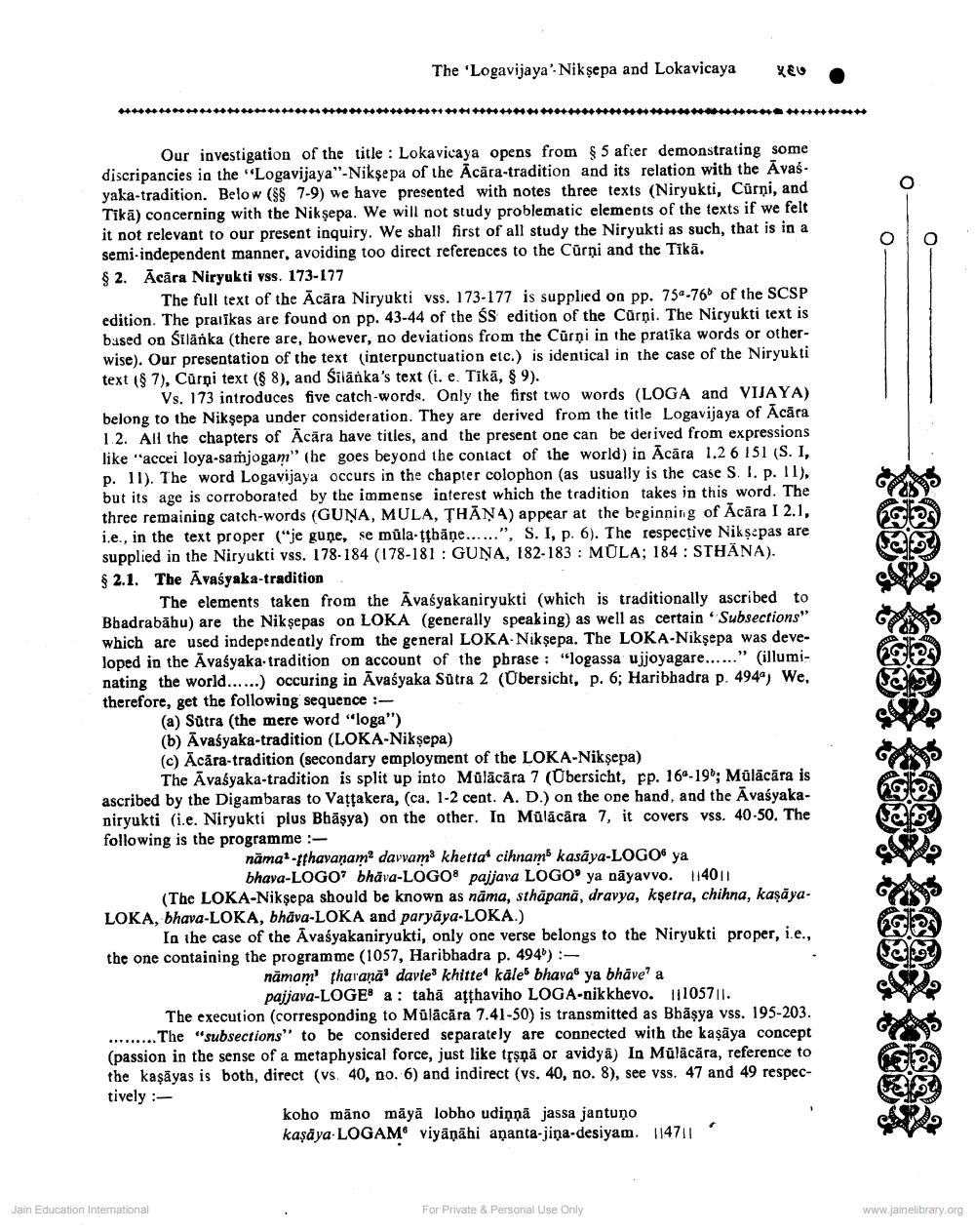Book Title: Logavijaya Niksepa and Lokavicaya Author(s): Bhatt Publisher: Z_Pushkarmuni_Abhinandan_Granth_012012.pdf View full book textPage 2
________________ The 'Logavijaya’Nikṣepa and Lokavicaya yêu . Our investigation of the title : Lokavicaya opens from $5 after demonstrating some discripancies in the "Logavijaya"-Niksepa of the Ācāra-tradition and its relation with the Āvasyaka-tradition. Below ($$ 7-9) we have presented with notes three texts (Niryukti, Cürņi, and Tikā) concerning with the Nikşepa. We will not study problematic elements of the texts if we felt it not relevant to our present inquiry. We shall first of all study the Niryukti as such, that is in a semi-independent manner, avoiding too direct references to the Cürni and the Tikā. § 2. Ācāra Niryukti vss. 173-177 The full text of the Acara Niryukti vss. 173-177 is supplied on pp. 75-760 of the SCSP edition. The prailkas are found on pp. 43-44 of the SS edition of the Carni. The Niryukti text is based on Silanka (there are, however, no deviations from the Cürni in the pratika words or otherwise). Our presentation of the text (interpunctuation etc.) is identical in the case of the Niryukti text ($ 7), Curņi text ($ 8), and Silänka's text (i, e. Tikā, $ 9). Vs. 173 introduces five catch-words. Only the first two words (LOGA and VIJAYA) belong to the Niksepa under consideration. They are derived from the title Logavijaya of Ācāra 12. All the chapters of Acära have titles, and the present one can be derived from expressions like "accei loya-samjogam" he goes beyond the contact of the world) in Ācāra 1.2 6 151 (S. I, p. 11). The word Logavijaya occurs in the chapter colophon (as usually is the case SI. p. 11), but its age is corroborated by the immense interest which the tradition takes in this word. The three remaining catch-words (GUNA, MULA, THĀŅ4) appear at the beginning of Acara I 2.1, i.e., in the text proper (je gune, se mula-tbäņe... ...", S. I, p. 6). The respective Niksepas are supplied in the Niryukti vss. 178. 184 (178-181 : GUŅA, 182-183: MOLA: 184 : STHÄNA). $ 2.1. The Avaśyaka-tradition The elements taken from the Avaśyakaniryukti (which is traditionally ascribed to Bhadrabāhu) are the Niksepas on LOKA (generally speaking) as well as certain Subsections" which are used independently from the general LOKA. Nik sepa. The LOKA-Niksepa was developed in the Āvaśyaka tradition on account of the phrase : "logassa ujjoyagare.......” (illuminating the world......) occuring in Āvaśyaka Sutra 2 (Obersicht, p. 6; Haribhadra p. 494", We, therefore, get the following sequence : (a) Sutra (the more word "loga") (b) Avaśyaka-tradition (LOKA-Niksepa) (c) Ācāra-tradition (secondary employment of the LOKA-Nikṣepa) The Avaśyaka-tradition is split up into Mulācāra 7 (Obersicht, pp. 164-196; Mülācāra is ascribed by the Digambaras to Vattakera, (ca. 1-2 cent. A. D.) on the one hand, and the Avaśyakaniryukti (i.e. Niryukti plus Bhäşya) on the other. In Malacära 7, it covers vss. 40-50. The following is the programme : näma-fthavanamo davvam khetta cihnams kasāya-LOGO6 ya bhava-LOGO' bhäva-LOGO8 pajjava LOGO' ya näyavvo. 114011 (The LOKA-Niksepa should be known as nāma, sthäpanā, dravya, kşetra, chihna, kaşayaLOKA, bhava-LOKA, bhāva-LOKA and paryaya-LOKA.) In the case of the Āvaśyakaniryukti, only one verse belongs to the Niryukti proper, i.e., the one containing the programme (1057, Haribhadra p. 494"): nāmam tharaņā' davie' khitte käle bhava ya bhāve' a pajjava-LOGE a: tahä aţthaviho LOGA-nikkhevo. 11105711. The execution (corresponding to Mülācāra 7.41-50) is transmitted as Bhäşya vss. 195-203. ......... The "subsections to be considered separately are connected with the kaşaya concept (passion in the sense of a metaphysical force, just like tfsnā or avidyā) In Mülācāra, reference to the kaşāyas is both, direct (vs, 40, no. 6) and indirect (vs. 40, no. 8), see vss. 47 and 49 respectively : koho mano māyā lobho udinna jassa jantuno kaşaya LOGAM viyāņāhi aṇanta-jiņa-desiyam. 114711 Jain Education International For Private & Personal Use Only www.jainelibrary.orgPage Navigation
1 2 3 4 5 6 7 8 9 10
